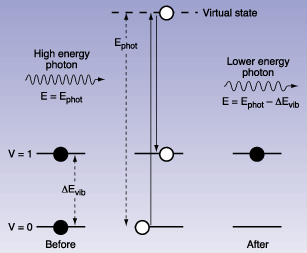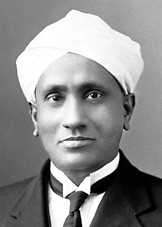Raman, Chandrasekhar Venkata (1888–1970)

In the Raman effect, part of the original photon energy is used to excite a resonant vibration – usually described as a three-level event via a virtual excited state.
Chandrasekhar Raman was an Indian physicist who was awarded the 1930 Nobel Prize in Physics for his discovery of the Raman effect: when a medium is exposed to a beam for electromagnetic radiation, light scattered at right angles to the beam has a range of frequencies characteristic to the medium. This is the basis of the Raman spectroscope.
Raman was professor of physics (1917–1933) at Calcutta University. He was director of the Indian Institute of Science, Bangalore, and in 1946 founded and directed the Raman Institute.
 |
Raman effect
The Raman effect, in spectroscopy, is the change in the wavelength of light that occurs when light undergoes inelastic scattering from atoms or molecules. It arises from radiation exciting (or de-exciting) atoms or molecules from their initial states.
Raman spectroscope
A Raman spectroscope is a type of spectrometer based on the Raman effect. Unlike most methods of analyzing a substance, it does not require destructive testing. By firing a laser at the sample, atoms are excited, which then emit a very weak light with a pattern characteristic of the material.


